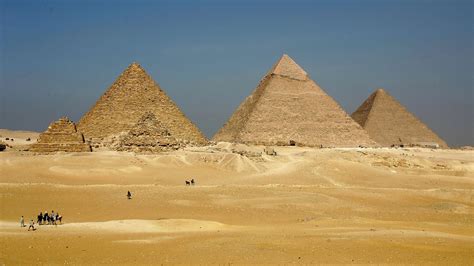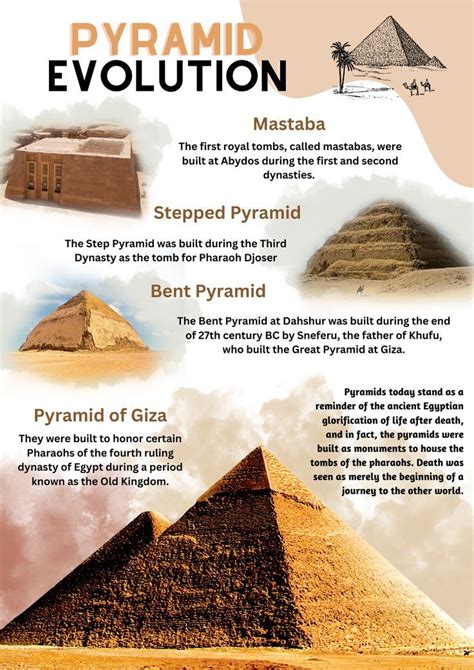The Egyptian pyramids have long been a source of fascination for people around the world. These ancient structures, built as tombs for the pharaohs of Ancient Egypt, are a testament to the ingenuity and skill of the Egyptian people. With their precise architecture and massive scale, the pyramids are an awe-inspiring sight to behold. But how much do we really know about these incredible structures? Let's take a closer look at 12 fascinating facts about the Egyptian pyramids.
Key Points
- The Great Pyramid of Giza is the oldest and largest of the three pyramids, built as a tomb for Pharaoh Khufu.
- The pyramids were built using around 2.3 million stone blocks, each weighing an average of 2.5 tons.
- The Great Pyramid is aligned almost perfectly with the four cardinal directions (north, south, east, and west).
- The pyramids were originally covered in smooth limestone to create a shiny, reflective surface.
- The Great Pyramid is estimated to have taken around 20 to 30 years to build, with a workforce of around 100,000 laborers.
- The pyramids were built using simple yet effective tools, such as copper chisels and stone mauls.
- The Great Pyramid has a total of 144,000 square feet of surface area.
- The pyramids were often built with internal chambers and passageways, including the King's Chamber and the Queen's Chamber.
- The Great Pyramid is the only one of the Seven Wonders of the Ancient World still standing.
- The pyramids were believed to provide a means for the pharaohs to ascend to the afterlife.
- The Great Pyramid is estimated to weigh around 5.75 million tons.
- The pyramids have been the subject of numerous theories and legends over the years, including claims of curses and hidden treasures.
Introduction to the Pyramids

The Egyptian pyramids are some of the most impressive architectural achievements in history. The three main pyramids, located on the Giza plateau, are the Great Pyramid of Giza, the Pyramid of Khafre, and the Pyramid of Menkaure. These structures were built over a period of several decades, with the Great Pyramid being the oldest and largest. The pyramids were built as tombs for the pharaohs, who were believed to become gods in the afterlife. The pharaohs were thought to need a means of ascending to the afterlife, and the pyramids provided a way for them to do so.
Construction of the Pyramids
The construction of the pyramids is a remarkable achievement, considering the technology and resources available at the time. The pyramids were built using limestone and granite blocks, some of which weighed as much as 80 tons. The Great Pyramid, for example, is estimated to have required around 2.3 million stone blocks, each weighing an average of 2.5 tons. The pyramids were built using simple yet effective tools, such as copper chisels and stone mauls. The construction process was likely to have been a massive undertaking, requiring a large workforce and a significant amount of resources.
| Pyramid | Height | Base Length | Volume |
|---|---|---|---|
| Great Pyramid of Giza | 481 feet | 756 feet | 2.5 million cubic feet |
| Pyramid of Khafre | 446 feet | 694 feet | 1.6 million cubic feet |
| Pyramid of Menkaure | 218 feet | 358 feet | 0.25 million cubic feet |

Pyramid Architecture

The pyramids are remarkable not only for their size but also for their precise architecture. The Great Pyramid, for example, is aligned almost perfectly with the four cardinal directions (north, south, east, and west). The pyramid’s base is a square, with each side aligning with one of the cardinal directions. The pyramid’s internal chambers and passageways are also precisely aligned, with the King’s Chamber and the Queen’s Chamber being two of the most notable features. The pyramids were originally covered in smooth limestone to create a shiny, reflective surface, which would have been visible from a distance.
Pyramid Legends and Theories
Over the years, the pyramids have been the subject of numerous theories and legends. Some people believe that the pyramids hold hidden treasures or secrets, while others believe that they are cursed. The pyramids have also been the subject of numerous conspiracy theories, with some people believing that they were built by extraterrestrials or that they hold the secrets of the universe. While these theories are intriguing, they are not supported by scientific evidence and are largely the product of speculation and imagination.
What is the purpose of the pyramids?
+The pyramids were built as tombs for the pharaohs of Ancient Egypt, who were believed to become gods in the afterlife. The pyramids provided a means for the pharaohs to ascend to the afterlife, and were often filled with treasures and provisions for the journey.
How were the pyramids built?
+The pyramids were built using limestone and granite blocks, some of which weighed as much as 80 tons. The construction process was likely to have been a massive undertaking, requiring a large workforce and a significant amount of resources. The Egyptians used simple yet effective tools, such as copper chisels and stone mauls, to build the pyramids.
What are some of the most interesting facts about the pyramids?
+Some of the most interesting facts about the pyramids include their precise architecture, their massive size, and the fact that they were built using simple yet effective tools. The pyramids are also aligned almost perfectly with the four cardinal directions, and were originally covered in smooth limestone to create a shiny, reflective surface.
In conclusion, the Egyptian pyramids are incredible structures that continue to fascinate and inspire people around the world. With their precise architecture, massive size, and rich history, the pyramids are a testament to the ingenuity and skill of the ancient Egyptians. Whether you are interested in history, architecture, or simply want to learn more about these incredible structures, the pyramids are sure to captivate and inspire.



